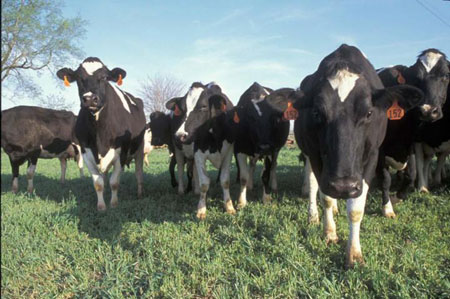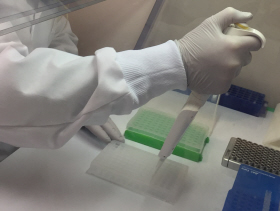



On the leading edge of microbiome science
As part of The Cattle Site’s deep dive into new trends in nutrition, we spoke to Mike Seely from Ascus Biosciences to discuss their unique approach to microbiology and animal-health science.Ascus Biosciences is an American microbiology company that has pioneered a new approach to microbiome science. Endomicrobial ecology – the company’s research ethos – involves comprehensively screening the animal’s native microbial community and capitalising on those microbes to boost welfare and performance. When their supplements are added to daily feed rations, they find that GI health and function improves, while digestibility and secondary benefits become more pronounced.
According to Mike Seely, the commercial founder of Ascus, their deep-science approach distinguishes them from their industry peers. When he and his scientific co-founder, Dr Mallory Embree, researched the microbial feed additives on offer, they found that their competitors’ products often used microbes repurposed from other industries. The ingredients weren’t based on any type of discovery science and didn’t appear to incorporate any modern microbial genomics science. Many of the microorganisms in those products didn’t live indigenously in the animal’s digestive environment – something Seely and Embree thought was a crucial oversight.
Seely and Embree believed that instead of relying on non-native microbes like yeast (Saccharomyces cerevisiae), they would capitalise on native animal microbes that conducted biochemical transformations pertinent to each animal’s health and performance. This essentially meant building products from the bottom-up – a challenging premise for a new business.
This data-driven approach appears to be gaining traction: after developing their first endomicrobial product for dairy cattle, they have deepened their R&D pipeline across multiple livestock and companion animal species. Their flagship feed supplement for dairy cattle, Galaxis, is currently available in central and South America, and will be launched in the US later this year.

The science behind the business
In developing Galaxis, the research team at Ascus began by extensively profiling rumen samples in dairy cows. During the profiling process, the team identified target microorganisms and learned how they operated in the complex ecology of the rumen. They then had to learn how to administer these microbes orally to cattle through feed – an additional development challenge.
In many cases, rumen microbes are sensitive to life outside their native environment. The microbes can be obligately anaerobic [only living in environments which lack oxygen], grow more slowly and be sensitive to some of the peroxides present in silage. Because of this, delivering these novel microbes back to the rumen alive required significant investment in process development and manufacturing. It also involved creating a handling procedure that was customer friendly.
Minding the microbes
The microbial genomics profiles Ascus curated presented unique challenges, Typically, the microbes weren’t very stable or resilient outside the rumen. They were also rare. “Most of the time, our data sets will point to a microbe with a weirdo taxonomy – and you have to name it, basically!” Seely begins.
“Most of the time, the microbes we’re really interested in don’t sporulate [form spores and reproduce] well. There isn’t a lot of public domain knowledge of how we can manufacture and deliver them to customers reliably. Our microbial genomics profiles would rarely point to a spore-forming Bacillus as an important microbe. Those microbes are easy to deal with – you could probably send that thing to Mars and it would be fine. But unfortunately, that wasn’t the case.”
The commercialisation process was also complicated by the backgrounds of the founders: neither Seely nor Embree were familiar with conditions on-farm when they began their research. Since Seely and Embree were firmly rooted in bioengineering and technical microbiology, Seely admits that a dairy cow was an abstract concept for him. “When we started the company, it was a bunch of people doing microbial genomics, not necessarily doing applied microbiology or practical product microbiology; it was a totally different skillset and none of us had backgrounds in the animal sciences,” he says.

Translating their lab-based findings into practical and reliable feed supplements meant creating novel delivery technologies and systems. In order to bridge the gab between the lab and the farm, Seely’s team relied heavily on customer feedback while designing products and delivery methods. This meant that Ascus was able to combine their core microbial profiling skills and keep and eye on the on-farm reality where Galaxis would be used. The results are a product that improves rumen performance in a reliable, repeatable and easy-to-use manner.
Future focus
In Seely’s view, Ascus is built on a very strong microbial genomics discovery platform: the bottom-up, endomicrobial-ecology framework can be successfully adapted to multiple animal species. Ascus is currently focusing on beef feedlot cattle – developing a supplement for beef feeder cattle that capitalises on an unexpected set of microbial metabolic pathways and fermentation byproducts. Initial research indicates that it will make the cattle more efficient and resilient on high-grain diets. Seely emphasises that all Ascus products must follow a similar R&D narrative, further distinguishing itself from other companies in the sector.
“Going forwards, one needs to take a deep-science approach to build useful microbial products for animals. Taking repurposed commodity microbes like Saccharomyces or Lactobacillus isn’t what [the industry] should be doing to help our customers stay competitive and thrive. These antiquated microbes don’t provide them with the microbial mechanism and microbiome shifts needed to be successful. It’s on all of us as technology developers to push the microbiology wave forward.”
When asked about how the animal microbiome industry will develop in the coming years, Seely indicates that we’re entering new territory. “It’s exciting to see how many people are working on this – in 10 years’ time we’ll look back at the first stage of microbial feed additives and see how quickly it changed for the better.
“It’s important that the industry and technology developers continue to push the ball forward. It’s on all of us, as the people doing the work, to continue to put in the time and the resources to make it happen – for animals, those that care for them and society at large.”



